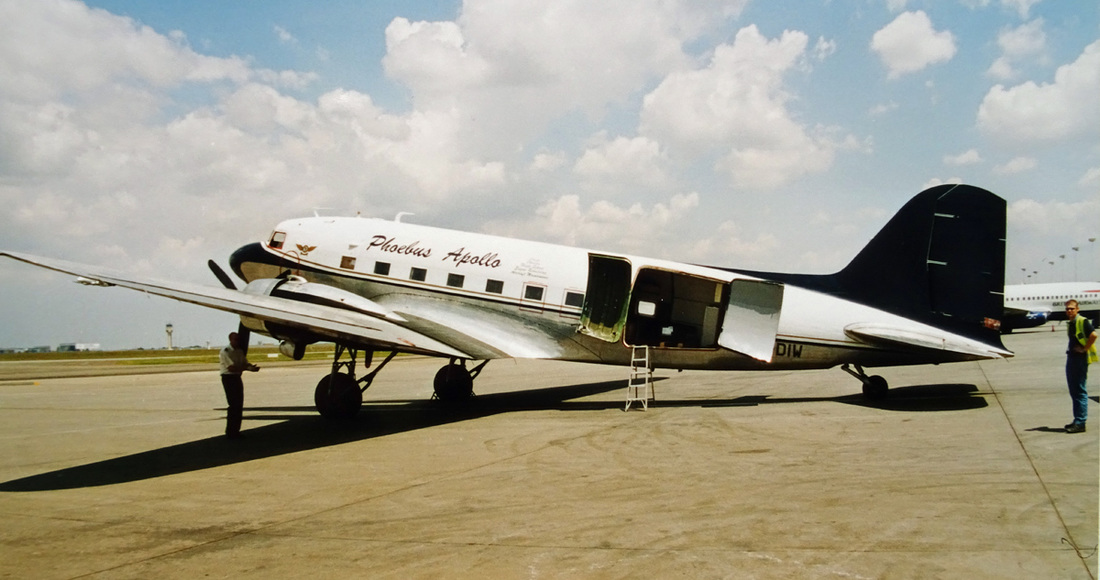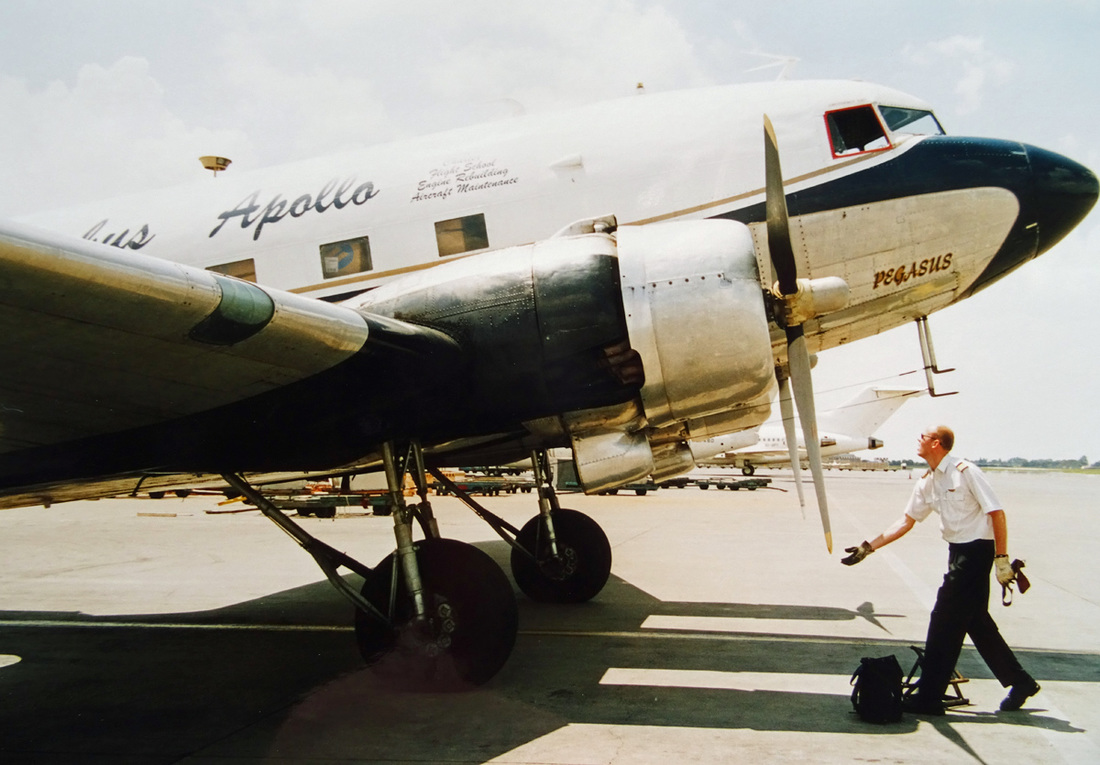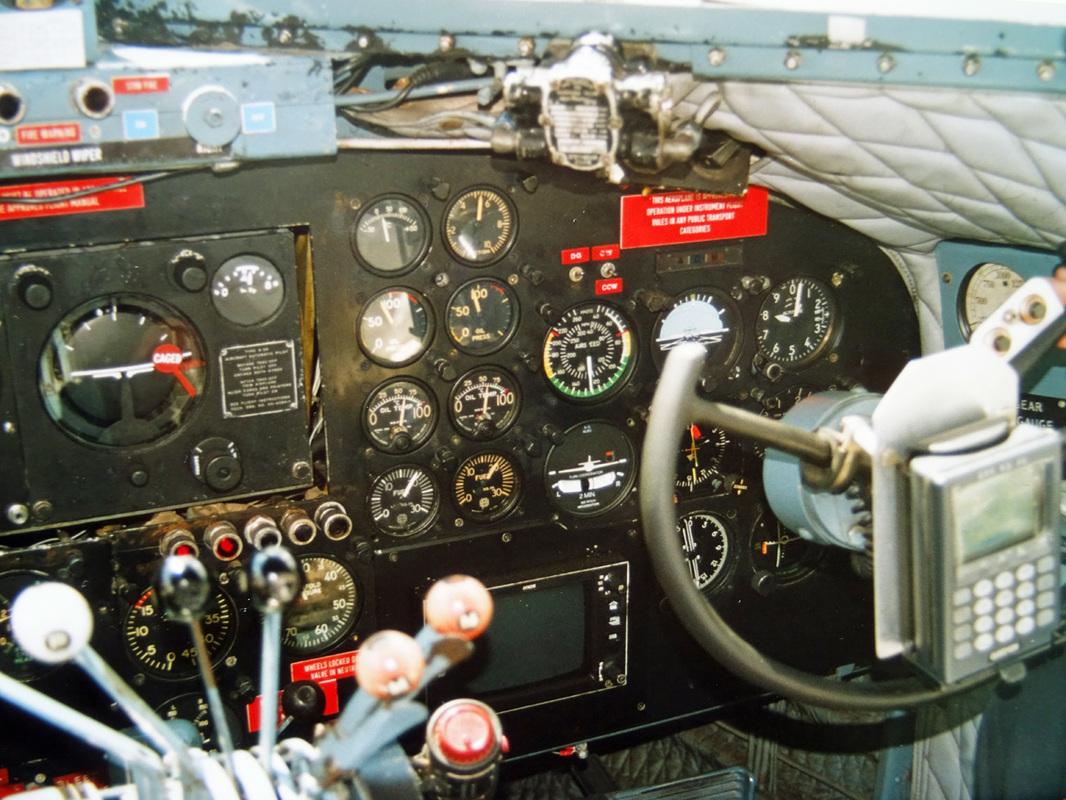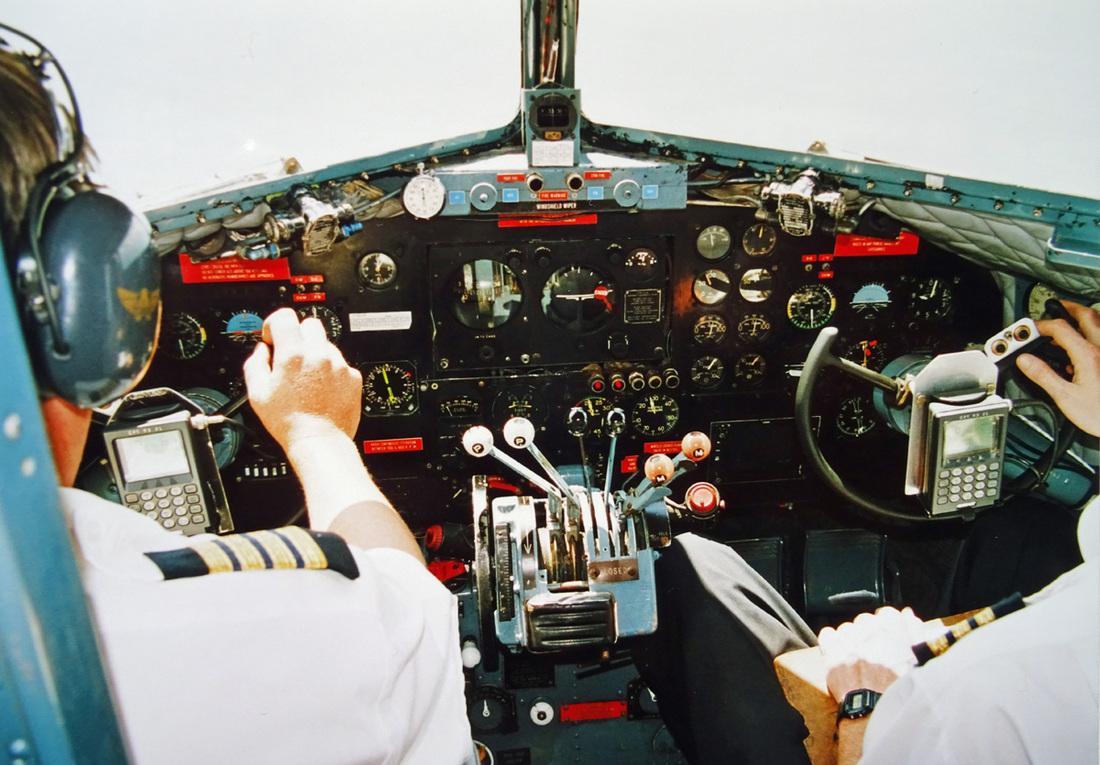Botswana 9280 to Gabarone
DC-3 Safari in Africa
|
When working for KLM Cargo, one is always surrounded by modern jets. Once in a while, the need for some aviation nostalgia must be fulfilled! Already in 2004 the choice was limited. Fortunately South Africa was in 2004 a land still with a good number of operational second-generation jets and a reasonable number of propliners. During 2004 the sky above Johannesburg's Jan Smuts International Airport was not overly populated by whispering Airbuses and new generation Boeing 737s. Here, screaming P&W JT8Ds of venerable Douglas DC-9s, Boeing 727s and 737-200s still dominate the sky!
The DC-3 in South Africa During 2004 Phoebus Apollo, Rovos Air, Dodson International, Nelair, Naturelink and Springbok Flying Safaris operated DC-3 passenger and cargo services from the Johannesburg area. Phoebus Apollo operated a twice-weekly cargo service on behalf of Air Botswana from Johannesburg to Gaborone, Botswana. Dodson was flying in 2004 for the International Red Cross providing relief goods. Rovos Air, Nelair, Naturelink and Springbok Safaris were flying in 2004 tourists from their bases at Lanseria, Nelspruit, Pretoria-Wonderboom and Jo'burg-Rand to the Victoria waterfalls near Livingston, Zambia, and the many wildlife parks within South Africa and I was determined to jumpseat on at least one of them! Meet and greet with Johan and Laurie Jan Smuts Airport is located some ten kilometers east of Johannesburg city and is easily reached by a 30-minute taxi ride from the city center. To avoid the bad crime situation in the city center, I stayed at a low-key airport hotel. After a night's sleep, I scrambled via taxi to the airport to catch Phoebus Apollo's eleven o'clock DC-3 freight service to Gaborone. In the operation room I met the crew for flight PHB9280. In command of the flight was Capt. Johan Scholtz. After working 15 years as a mechanic on C-130s, Johan started his flying career. His experience on propeller-driven aircraft is impressive, having flown Cessna Caravans, DC-3s, DC-4s and the Carvair all over the African continent for various South African airlines. He has accumulated thousands of hours on the round-engined classics. With such a record, he was well-qualified for the task ahead. The much younger Laurie Mey, who had a wealth of experience as a flight instructor, was his co-pilot. -Delta India Whiskey- history file On the ramp was the pristine Douglas DC-3 ZS-DIW, glistering in the morning sun. The wings, to which two dependable Pratt & Whitney R-1830-92s were attached, were not fitted with de-icer boots. "India Whiskey" was completed in 1943 as a C-47D and delivered to No. 28 Squadron of the South African Air Force with the serial 6871. In 1953, she was sold to Aircraft Operating Corp. who sub-contracted the Gooney Bird to Suidwest Lugdienst and the Anglo-American Corp. for many years. In December 1978, she went on to serve for Namibair. In an auction at Cape Town in February 1989, Regional Air bought the plane. Finally, she was purchased by Phoebus Apollo in April 1996. Introduction with 'DIW' I was introduced to the aircraft by Laurie Mey. The first chore of the day involved the pre-flight inspection of the DC-3: Removing gust locks, checking engine oil and fuel levels, and checking the overall airworthiness of the aircraft. Once these checks were completed, we entered through the small door mid-way between tail and wing. Our DC-3 was already being loaded with 4000-lbs (South Africans use pounds instead of kilos) of general cargo, winched slowly forward up the sloping cabin floor and properly strapped. The fuel tanks were replenished with 400 US gallons (2400-lbs). Fuel burn would be a hefty 50 gallons per hour. A dry operating weight of 18,720-lbs and three souls onboard made a takeoff weight of 25,084-lbs ... well under her max take-off weight of 26,908-lbs. Time to go The door closed at 13:30 local time and I made my way forward into the cockpit and took my place on the leather-covered, tube-framed jump seat behind the pilots. The instrument panel had been updated, for the most part, with advanced radio's, instruments and a GPS. The overhead switches, flap controls and landing gear actuator handles were 1940s' vintage. The once-brilliant red paint on the emergency panels and the control pedestal had faded into dull splotched blotches. Under the watchful eye of ground staff armed with a fire extinguisher, Johan prepared for engine start-up. This involved turning the master, ignition and booster switches on, setting the mixture controls to idle cut-off and cracking open the throttles. The rocker switch was positioned to the left engine and the starter switch was engaged. After counting nine blades the mixture control was set to auto-rich and the Pratt & Whitney radial sprang into life after a few coughs, a wheeze, and a puff of exhaust smoke. With the Hamilton Standard propellers now flashing past at 1000 revolutions a minute, Johan carefully monitored the oil pressure. The procedure was then repeated with the left-hand engine. Needless to say, number one engine start-up also resulted in much white smoke and loud engine sound. Departure from 03L Allowing the R-1830s time to warm up prior to departure is a very important procedure in order to extend their life cycle. Once the Pratt & Whitney’s had warmed up, Johan steered DIW gingerly over the crowded ramp. We rolled out to runway 03L, passing a long line of interesting African Boeing 727s, DC-8-50s and Ilyushin-76s freighters. Before lining-up, power checks were commenced when both men checked the feathering system. Then the engines were run up to 2500-rpm with the yokes held hard back and both men clinging to the bucking columns. They still jerked frantically as Johan ran up to static boost for the magneto checks. Everything checked out fine and both engines indicated that they were up to the task. It was time to fly! With clearance received at 13:47, Johan lined her up on the runway, locked the tailwheel, set the friction locks on the throttles and increased power to 2600-rpm and 35-inches of manifold pressure. The normal procedure is to baby the engines by using no more power than necessary for takeoff. With 14,495-ft of runway, 35-inches of manifold pressure is sufficient and the radials will have longer operating lives. Johan released the brakes and we were on our way! The tail came up very rapidly and the old bird was eager to fly, but Johan kept her pointed straight down the runway until we reached 90-kts. At that point, he relaxed forward control pressure and she flew off the runway. Once the 95-kt single-engine climb speed was indicated, Johan called for gear-up and Laurie released the up-locks, then hauled up the big lever on the floor beside him. At 100-kts, with the gear in transit, Johan called for a reduction to climb power setting of 33-ins and 2300 rpm. Laurie moved the throttles and pitch levers simultaneously to the desired setting. Oil temperature was checked and confirmed at 65-degeress. Once off the surface and wheels in the wells, we made a shallow turn to the northwest and passed over Lanseria Airport on course for the 161 nautical mile trip to Gaborone. Climbing steadily, the sturdy Douglas was soon purring along in the cruise at 8000-ft while we set course for the Pilanes VOR and before long we were cruising at a healthy 135-knots on a heading of 309-degrees. It was a beautiful day It was a beautiful day and it was great to watch Johan and Laurie ease the old girl through the South African airways. According to Johan, 8000-ft their DC-3 air conditioning level so the sliding side windows were partially opened for much needed cool air! I found the nose surprisingly low in cruise and the forward view was very good. The predominant cockpit sound is of the slipstream, rather than the resonant drone of the radial engines. But nevertheless, the reassuring thrumming of the R-1830s, just outside the windows, was not conductive to conversation other than by intercom. Listening into the R/T revealed little traffic, with only some Federal Air commuters sharing the frequency. Ten minutes later we passed the well-known Sun City resort. After about 40-minutes in flight, one of South Africa's typical landmark features appeared on the horizon. By watching over the shoulders of the crew, the lesser-known Dwarsberg Mountains passed gracefully beneath the swept wings of the DC-3. The mountains have flat, slightly sloping peaks with their vertical walls having been carved out by erosion over millions of years and they rose dramatically from the rugged bushvelds below. Gaborone approach Time passed quickly, and before long we started descent at 120-kts with 25-ins and 2050-rpm. About 15 nautical miles from Gaborone, Johan pointed out that Gaborone was appearing on the horizon. Neck were craned to watch for any other traffic as we entered a standard right-hand circuit. Gaborone Approach handed us over to tower at 118.30 and shortly afterwards Johan called for gear down, flaps and 23-ins manifold pressure with 2050-rpm on the props. With all the landing checklist items ticked off, we were on short final to Gaborone’s runway 08. With the engine throttled back to 17-ins and full flaps, we glided over the threshold. Seconds later power was cut and after a single brief skip and a bit of pushing and pulling, Johan edged the controls forward to pin the sturdy Douglas on the runway. A few seconds later, the tailwheel came down. Laurie retracted the flaps while Johan started squeezing the brakes and soon we were slowed down to walking pace, only using up less than half the runway. Laurie completed the rest of the after-landing checks, while Johan back-tracked along the runway to our assigned parking spot close to the modern control tower. On block-arrival, Laurie closed the fuel mixture levers, shutting down the engines. As the propellers wound down, we were greeted by a bustling group of ground handlers, eager to unload our cargo. We left for the small airport terminal canteen to buy a cool refreshment. Gaborone Gaborone, the capital of Botswana, is situated along the border with South Africa. The airport is located just outside the city and, for a small airport, has some interesting aircraft. Air Botswana's ATR-42s and BA-146-200s are all based here and, in a corner of the airport, Spectrum's Turbo DC-3 was parked. In front of the terminal, two Airtech CN-235s of the Botswana Air Force were present. Other visitors were several light aircraft of DHL and some local operators. Back to Jo'burg Unfortunately for me, our time on the ground was a scant 45 minutes. ZS-DIW had been unloaded and our time for departure came. Our return trip to Jo'burg - now operating as Air Botswana 9281 - tracked low over the Pilanesberg wildlife park and essentially retraced our outward journey. The air rapidly became turbulent. Heavy thundershowers, lightning and hail were coming down as we neared Sun City. The controls required a fair amount of muscle power but the two Pratt & Whitney radials kept humming reassuringly. We began our descent well before reaching Johannesburg City. We were vectored for runways 03R With rain still pounding on the fuselage, the tower vectored us for a left base to runway 03R. As we turned onto final, the approach lights confirmed we were right on the glide slope. With the characteristic squeal of the tires, we were back on the ground. As we were taxiing back to our parking spot, I reflected on what a great day it had been and how lucky I had been to be able to fly such historic craft and I hope that round-engined classics like DIW will continue to meet the challenges of South Africa's unique operating conditions. Captain Johan Scholtz, F/O Laurie Mey and the author in front of Delta India Whiskey. |














